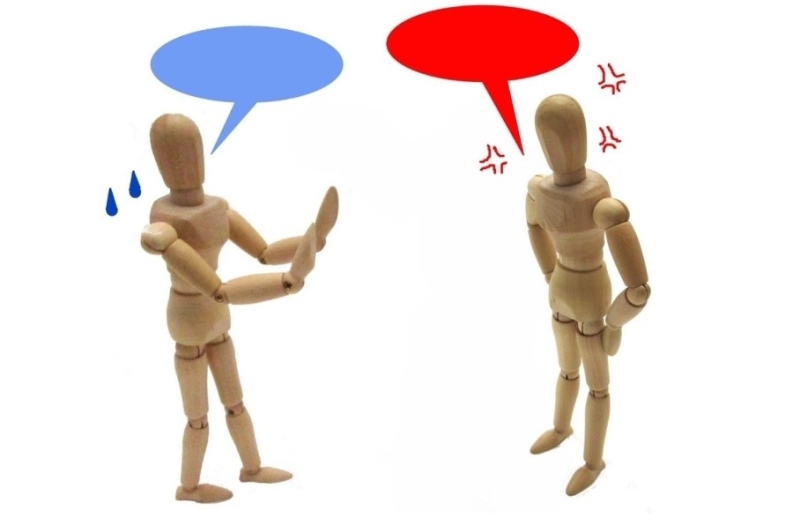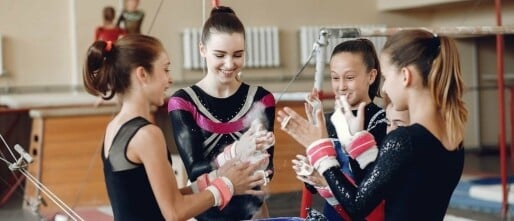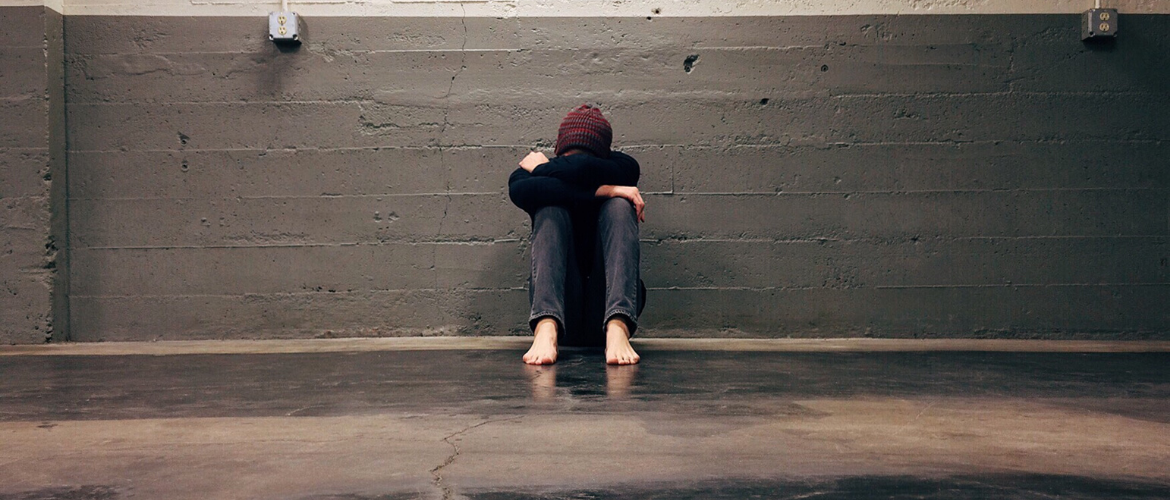Dealing with fear in gymnastics. There are various fears that occur in gymnastics.
- Fear of falling. This is a physical fear, afraid of feeling pain.
- Fear of failure. This is a personal fear. Fear of failure also often plays a role in gymnastics. There are many athletes who are very ambitious and want to do everything perfectly. The sport tends to have a tendency to do everything perfectly, which also causes a lot of fear of failure and perfectionism.
- Fear of going off. This is a social fear. For example, fear of falling down in the hall and being laughed at by the other athletes.
In this blog, I will discuss the fear of falling, which is a common problem in gymnastics. It is very dependent on the apparatus and gymnastics element. In women's gymnastics, there is often a fear of falling off the beam. Male gymnasts are more afraid of flying elements or jumping off the horizontal bar. They are less afraid of the pommel horse, which is a lot lower on the ground. It is therefore different for each athlete and also for each apparatus and gymnastics element where there is more fear.
The importance of acknowledging the fear
I would first like to show you a video to illustrate that it is very important that you, as a trainer, can deal with the fears that exist in gymnastics.
In the video you see an athlete running into the pegasus at full speed. It is an extreme case, but it is something that happens a lot in gymnastics, especially in jumping. When there are fears, there is a greater chance that an athlete will hesitate during the approach to the jump. So, for example, they will walk next to it or, in this case, they will jump against it or against the cupboard. This is an example of why it is so important to deal with fears.
You want your lessons to be as safe as possible, of course, and that is something that plays into your role as coach. You have to be able to deal with the fears that exist in gymnastics and you have to give your athletes enough confidence.
How do you deal with it as a gymnastics coach?
Know the familiar stumbling blocks. For many athletes, these are the flight elements, for example. For the ladies, this is the bridge and for the men it is the horizontal bar. For men, there are also a number of elements where you let go and jump off the bridge. So the dismounting and the flight elements are elements that are generally very exciting for the athletes. Especially because they are afraid to hit the pole. That hurts, of course, and the more pain involved, the greater the fear.
Jumping is also a common 'fear device'. Especially younger athletes often find the jump very scary. It is also often very high, especially if they have to work towards the pegasus.
For the ladies, the beam is the apparatus with which fears are most present. The beam has a narrow surface that gymnasts can easily fall off of, so fear is often a factor here as well. Of course, this differs per athlete, but in general there is more fear among women than among men. Male athletes are a little less careful, sometimes too little. You have to slow them down sometimes, whereas with women you have to be more empathetic and give them more confidence to be able to do things.
Build up elements slowly. Make sure that you build up everything in steps and do not work too fast towards the final element. In this way, you avoid creating more fear.
Prevention is better than cure
Once fear is there, it is very difficult to get rid of it. So anything you can do to prevent fear from happening to an athlete is a good thing. That is why it is better to build up slowly instead of going too fast and then having to solve everything. Let young athletes experience a lot. Build up everything in methods and steps calmly. Let them gain a lot of experience to work towards the final element in the future. In this way, they start to recognise things and have the feeling that they can do it.
Anxiety meter
This is to name how much fear arises in an athlete. This is very different for each athlete. One athlete has a more fearful disposition than the other. It also requires you as a coach to be able to play into this. If someone falls and it hurts, the fear often rises and they have less confidence in themselves or in the apparatus. Or possibly in the trainer who catches the athlete. For example, if you are providing assistance as a coach and you let someone fall, then of course the confidence goes down as well.
In successful attempts, fear goes down and confidence goes up. But in falling, confidence goes down more than confidence goes up in successful attempts. This means that a fall outweighs a successful attempt. Usually we have more fear of falling, so it is important that you, as a coach, ensure that there are so many successful attempts. And so that there is little room to fall or to fall painfully. Build it up slowly, then you make sure that the confidence eventually becomes greater than the fear of falling. In this way, the athletes gain a lot of self-confidence and are not afraid to fall. If they do fall, this is often a self-fulfilling prophecy: if they think "I must not fall", then they will usually fall. That is also something you want to avoid as a coach.
Can you solve fear?
If you have an athlete who suffers from anxiety or has a very anxious disposition, here are some tips:
- Calm down. Sometimes, as a coach, you can react out of frustration and think that if we try to get through to an athlete, he will benefit from it. Usually it is better to calm down first.
- Showing understanding. Next, we are going to show understanding to the athlete. Understand that it is exciting, be empathetic towards the athlete instead of forcing them.
- Which athlete is it? Some people need a little push. Another needs a lot of self-confidence, so how you deal with it is very different for each athlete. It is good for you to first take a step back. And to see which athlete it is and how you can best deal with it.
- Method. Then you will see which method works for you. There are a number of methods you can use to deal with fears. It's also good to look at each athlete and test which method works for them. So there is not one fixed method. It is precisely the challenge for you as a coach to see which athlete you have in front of you. And which method works best for that person to overcome the fear.
Methods
There are so many methods, but I will show you the ones I have used myself in practice. There are, of course, many other methods. And it is also possible that you use other methods. If you have any tips that you would like to share with other coaches, please let me know in the comments section.
The relativisation method
Here you help athletes to think "How many times have I fallen and how many times did it go right? How likely is it that it will go wrong?" Often athletes are very afraid of something, while if you ask them "Exactly how many times have you fallen from the bar?", it turns out that they have never fallen but they are still afraid of it. For some athletes, it can be very helpful to put this into perspective. So if they know that they have never fallen but they are afraid of it, they can ask themselves: "What am I afraid of? Is that fear realistic?", then they don't have to think about it anymore. For some athletes, it works very well to put their fears into perspective and in this way to take away the fears.
The action thinking method
This is a method that I myself like very much with many athletes. And it is by far the most effective among athletes. With this method, you mainly think action and think about the things you have to pay attention to during the movements. If you are talking about a handstand for example, then you have several actions to perform. During the handstand, you're not going to think that you don't want to fall off the bar but you have to do an action. Because of this, the athlete has no time to think about what could go wrong. This ensures that his brain is focused on the things that do have to happen. In this way he cannot think properly about the things that can go wrong. And the things that cause anxiety. So this is actually a kind of distraction method. This works very well for many athletes.
An example with a handstand on the beam: "I have to put my arms along my ears, take a big step forward, put my hands far away, kick my leg hard", in order to go to the handstand that way. Then the gymnast already has four actions to perform in her head instead of "I must do a handstand and I must not fall, I must not fall." Then the chances are very high that she will fall. So the action method is very effective and a good distraction from the things they don't want to happen. I would definitely recommend testing this with an athlete who has a lot of fear.
The '3 = further' method
This is a fun method that I also use regularly. It is mainly about success. That means when someone has done something successfully three times, you go a little further. So, for example, the handstand on the bar, we did the handstand on the floor or on a line on the floor, and it worked three times. Then you take it a step further. For example, you move to a ground beam that is just a bit higher on the floor. Or you place a beam extender on the ground beam. In this way, you go further and further, step by step.
This is also a method that works very well for some athletes, so they know when they have succeeded three times that they are going to make it a step harder. It also gives them a lot of self-confidence, so they know where they stand. Some athletes find it very difficult if they cannot tell themselves when they can continue. This method is clear to you as a coach, but also to your athletes. You are giving them a say in the matter, which is why this method is very successful and generally works very well.
The self-initiative method
This is an empathic method in which you don't think from your point of view as a trainer of "What needs to be done now to overcome the fear?", but you bring it more to the athlete. You look at what the athlete needs. In doing so, you automatically ask more questions as a coach instead of being the leader yourself. A question you can ask here is: "What do you think you need in order to dare again?", with this the athlete himself can indicate what he needs and this works especially well with somewhat older gymnasts who can think about it.
Sometimes it also works with the younger gymnasts if you notice that the other methods are not as effective. If they can indicate well what they think they need, you also notice that they often support it better themselves. This increases the chance that it will be effective. For example, a gymnast may indicate that she wants to take a step back or that she is willing to go on the beam but with a mat next to it. These are sometimes things that you wouldn't have thought of yourself as a trainer, which makes it a very good method to use. Especially if other methods were not effective. You can certainly test this in your lessons.
The step-by-step method
This is a method that works like a checklist. You create a step-by-step plan together with the athlete so that you give the athlete and yourself more insight into the learning process. For example, an athlete who has a lot of difficulty with jumps off. He was very good at jumping off the bridge and the horizontal bar. But he found it very scary and he had fallen a few times and was very afraid of it. This is something that happens a lot in gymnastics. We have tried many different methods with him but every time he had a relapse. The fear kept coming back to the apparatuses so that we could not continue. In this case, we made a schedule and indicated which exercises we would do each time.
The next week it would get harder and then we would tick off the exercise each time. This method is a bit like the '3 = further' method, but it is based on the training. This way, the athlete knows in advance what is going to happen during the training. In this way there will be less resistance from the athlete to cooperate. Especially if he himself has thought about this process, when he wants to be ready to move on to his final goal. It worked super-effectively with this athlete, which is why it is also a method that works well as a tool to ensure that the athlete overcomes his fear. Be sure to include it in your baggage as a gymnastics coach.
Additional tips
It is better to take a step back than to refuse more often. It is often better to take a step back than to refuse an athlete, especially if the athlete often refuses to perform an element. For example, if he does not continue running at a jump and ends up running next to the pegasus or stops running. It is then a lot more difficult to continue. It is also very dangerous if an athlete refuses to perform an escape element or a dismount. If someone half lets go of the horizontal bar, this can cause accidents. So it is better to take a step back to ensure that something really succeeds and with a lot of conviction from the athlete. It is better to take a step back to ensure that something really works and that the athlete has a lot of conviction than that there is a refusal and that the shins occasionally hit the stick during a backwards somersault. You really want to prevent that.
Try to put your trainer's frustration aside! Really look at how you can help the athlete step by step. In doing so, try to put your own ambitions and goals as a coach aside for a moment. And really look at how you can best help that athlete. That will effectively help the learning process and with that you will eventually get the most results. With which you will ultimately still achieve your objectives. This is often a better method.
Getting angry effective?
Getting angry is usually not the right solution. There are coaches who indicate that it is sometimes an effective method and it can work with some athletes to give them a push. Or to raise your voice or get slightly angry. I myself am less in favour of this. I think it often achieves the opposite and I am more in favour of a positive learning environment. So I will always avoid getting angry as much as possible.
Get different people to help. As a coach, you provide quite a lot of help. Make sure that you can help on both sides as a coach. And do it so that an athlete learns to catch a gymnastics move in different ways. So, for example, catch the somersault on your left side, but also on your right side, so that you as a coach become better at giving help. The athlete also benefits from this. It is very different for an athlete the moment he has to perform an element on the other side. It is also different when someone else provides assistance. That is only a good thing to do.

More tips?
I hope these tips and methods have helped you. As I said, there are many more methods you can use. Let me know in the comments if you have a nice variation of your own. If you need more tips, we have downloads available on our website.
If you are a trainer and need more help with your lesson preparations and coaching methods, we have a huge platform with many methods, videos and PDFs. And a lot of other things on our platform that will help you to prepare your gymnastics lessons very easily and to coach your gymnasts even better.
I hope these tips and methods have been useful to you and I wish you good luck with your upcoming training sessions!






